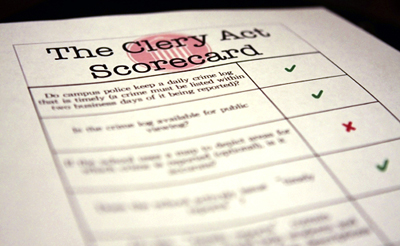Blog
Clery Act overview - a law to improve college and university security and safety
by Paul Kazlauskas

The Clery Act is a consumer protection law that aims to provide transparency around campus crime policy and statistics. The Clery Act requires all colleges and universities that participate in federal financial aid programs to keep and disclose information about crime on and near their respective campuses. Compliance is monitored by the United States Department of Education, which can impose civil penalties, up to $54,789 per violation, against institutions for each infraction and can suspend institutions from participating in federal student financial aid programs.
The law is named after Jeanne Clery, a 19-year-old Lehigh University student, whom Josoph Henry raped and murdered in her campus dorm in 1986. Henry's murder of Ms. Clery triggered a backlash against unreported crime on campuses across the country. In order to comply with Clery Act requirements, colleges and universities must understand what the law entails, where their responsibilities lie, and what they can do to actively foster campus safety and campus security.
Requirements of the act
Annual security report
By October 1st of each year, institutions must publish and distribute their Annual Campus Security Report to current and prospective students and employees. Institutions are also encouraged to provide notice of the report, a web address if available, and how to obtain a paper copy if desired. This report is required to provide:
- Crime statistics for the prior three years
- Policy statements regarding various safety and security measures
- Campus crime prevention program descriptions
- Procedures to be followed in the investigation
- Prosecution of alleged sex offenses
Record of Crimes
The institution's campus security department is required to maintain a public log of all crimes reported to them, or those of which they are made aware. The log is required to have the most recent 60 days’ worth of information. Each entry in the log must contain:
- The nature, date, time, and general location of each crime
- Disposition of the complaint, if known
Information in the log older than 60 days must be made available within two business days. Crime logs must be kept for seven years, three years following the publication of the last annual security report.
Timely warnings
The Clery Act requires institutions to give timely warnings of crimes that represent a threat to the safety of students or employees. Institutions are required to publish their policies regarding timely warnings in their Annual Campus Security Report. The institution is only required to notify the community of crimes that are covered by the Clery statistics.
Crime statistics
An institution must keep the most recent eight years (new provision as of 2012) of crime statistics that occurred:
- On campus
- In institution residential facilities
- In noncampus buildings
- On public property
Offenses are defined by the Uniform Crime Reporting Handbook and are not the state crime definitions, but rather federal crime definitions. This has led to possible discrepancies in data reporting. Some changes have been made to further define discrepancies in recent updates to the Clery Act. In 2014, new amendments were made to require reporting on domestic violence, dating violence, and stalking. In cases of forcible sexual offenses, there have been reports of colleges questioning accounts of alleged victims, further complicating documentation and policing of student assaults.
Institutions are required to report on crimes such as:
- Murder (including non-negligent and negligent manslaughter)
- Sex offenses (forcible/non-forcible, domestic violence, dating violence, and stalking
- Robbery
- Aggravated assault
- Burglary
- Motor vehicle theft
- Arson
- Arrest
Institutions are required to report on persons referred for campus disciplinary action for:
- Liquor law violations
- Drug-related violations
- Weapons possession
Institutions are required to report on crimes or bodily harm related to/caused by:
- Hate crimes
How to comply
Compliance with the Cleary Act can be attained by following the five processes below. These are not easy tasks to complete because of the detail required to be in compliance.
- Form a Clery Committee – Bringing together experts from across your institution’s administration (Security, Risk Management, Emergency Services, General Counsel, Student Affairs, and Human Resources among others) can greatly assist in developing clear, defendable policies and procedures regarding the Clery Act’s complex emergency communications requirements.
- Determine your Clery Act Geography – determine exactly where geographically the Clery Act applies to your campus community. Check Clery’s definition of “campus” and see how it relates to your campus.
- Understand the Clery Act requirements for Timely Warning and Emergency Notification – This is defined as “issuing a timely warning for any Clery Act crime that represents an ongoing threat to the safety of students or employees, and issuing an emergency notification upon the confirmation of a significant emergency or dangerous situation involving an immediate threat to the health or safety of students or employees occurring on the campus.”
- Create clear, defendable policies and procedures – It is very important for compliance that you document everything your Clery Act Committee decides upon, especially your institution’s specific conditions for adhering to the Clery Act. The procedures described in the plans and protocols should be vetted and agreed to by all members of the institution’s Clery Act Committee.
- Implement your program and include the information in your Annual Security Report – Implementing and improving the plans occurs on an almost daily basis. Use your plans and procedures accurately, disseminate emergency notifications and timely warnings per your policy statements on each, continue meeting with your Clery Committee, and make changes and revisions as needed.
The above is just an introduction to all that is involved in this campus security policy. To learn more, see the Clery Act Policy & Resources information from the Clery Center.
Want the latest, best security practices delivered straight to your inbox? Click the "Subscribe to the Blog" button (on the left side navigation).
Our visitor badges “VOID” overnight to prevent reuse.

See them for yourself — request free samples!
Posted on 4/25/2018



 Paul Kazlauskas
Paul Kazlauskas
 Andrew Jones
Andrew Jones